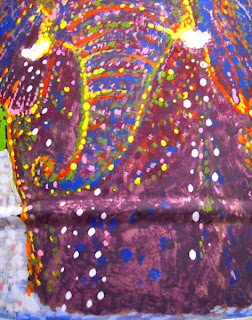I must admit that today was one of those days when I absolutely didn't feel like making art or doing a craft of any kind, but I'd already bought a metal pail to paint, so I bit the bullet and did it anyway.
I wasn't sure, despite combing the Internet and asking at art stores, whether or not acrylic paint would actually work on metal. Some sources say you need to prime or sand the metal first. Others say any acrylic paint will be fine. My theory is this: if I can paint on glass with a certain type of paint, I can use the same type of paint on metal. Having now used acrylics on glass with no ill effects, I decided to use acrylics on my galvanized pail.
This is the pail I bought. Not bad for two dollars.
I was pretty sure I wasn't going to want to create anything too realistic today. On the other hand, my creative imagination was a bit tired, so I decided to work from a photograph.
This is the photograph I chose. I chose it partly for the shape of the photograph—which I thought would fit nicely in the oblong area between the pail's ridges—and partly because there's water in the picture. After all, this was a pail I was painting.
 |
| A teenage elephant makes a warning charge, Okavango Delta, Botswana, 2010. Photo: Nick Pattinson Source: http://www.australiangeographic.com.au/journal/elephant-fiesta- in-the-okavango-delta.htm |
I started by drawing a faint sketch on the pail with pencil, then used a sort of black-purple to outline the elephant and add some rudimentary shading.
I decided to add more purple next, along with white for the tusks. One thing I discovered with this next layer of paint, however, was that, if anything is the least bit wet, the paint reactivates and moves around. So I decided to let this dry while I added some grass and water around the elephant.
After the grass and water had also dried, I painted more purple on top of the elephant. The more I painted, the less I liked it. I noticed that the paint tended to be streaky, and that even if I added several layers, it didn't get much better. I liked the metallic undertone, but the streaks weren't what I had in mind. So I decided to change tack.
The tusks had worked well because I'd used thick paint and a sort of pouncing/pointillism technique. I decided to try that on the rest of the design. I started on the grass and water, and kind of liked how it looked, so I began doing the same thing over the elephant.
Unfortunately, the elephant colours were strangely dark, no matter what I did, so I began using weird colours like orange and yellow and green. The paint still tended to get sucked into the surface, but I liked the way it looked a little more.
Once I'd done the elephant, I added some more dots to the water and grass to pull the design together. As a final touch on the elephant, I added some light blue to represent the water dripping from its tusks and trunk in the photograph.
It looked very abstract at this point, but I'd more or less had enough and didn't really want to go back to brushstrokes again. To finish up the pail, I scattered dots across the blank areas of the pail, using the colours I'd used in the elephant.
This activity was both easy and difficult. Painting galvanized metal with acrylic paint wasn't the greatest idea if using brushstrokes, and although the pointillism technique was easy and worked well, it was tedious. I'm also not positive about how well the design will last. Although it doesn't scratch off with my fingernail, given that I didn't prime the surface before painting, I should probably spray it with acrylic sealant at some point.
I'm not really sure what to do with this pail. The acrylic paint means that it can't really be used to haul water, and it's too big for paintbrushes or pencils. On the other hand, although I don't love the final design, it's not completely hideous, so maybe I'll use it to store small, unfinished projects. Or perhaps to contain some of the 300+ elephants currently littering my house.
Elephant Lore of the Day
Yesterday, my friend Michael sent me a stunning photo of a baby elephant in utero. It started me to thinking about elephants and their incredibly lengthy pregnancies.
 |
| Baby elephant in utero, from an upcoming Channel 4 documentary. Source: https://www.facebook.com/wildaid |
The average gestation time for a baby elephant is 22 months—the longest for any mammal on Earth. Pity the Asian elephant Azizah, however, who carried her baby for a whopping 700 days—84 days longer than average.
In humans, the longer the gestation period, the larger the baby. In Azizah's case, the exact opposite happened: her calf was the smallest ever recorded at London's Whipsnade Zoo, weighing a mere 104 kilograms (229 pounds).
So small was the baby that keepers worried that he wouldn't be able to feed. He proved a rather smart little fellow, however, and learned almost immediately how to stand on his toes to reach his mother's milk.
To
Support Elephant Welfare
Elephant
sanctuaries
(this Wikipedia list allows you to click through to information
on a number of sanctuaries around
the
world)














No comments:
Post a Comment